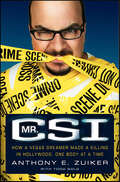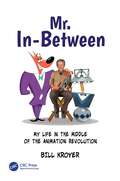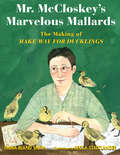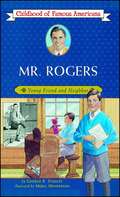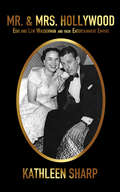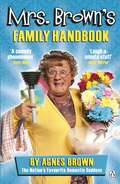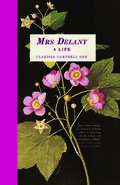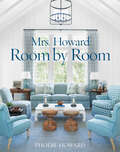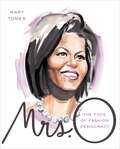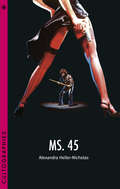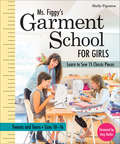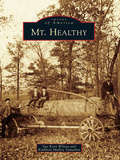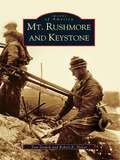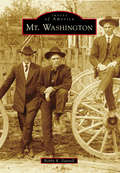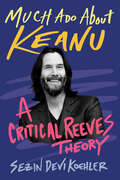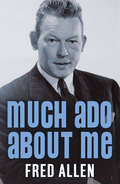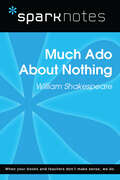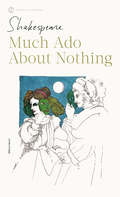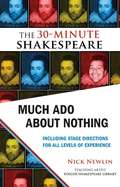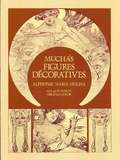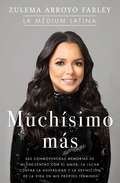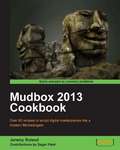- Table View
- List View
Mr. CSI: How a Vegas Dreamer Made a Killing in Hollywood, One Body at a Time
by Todd Gold Anthony E. ZuikerThe creator of CSIdelves into the mysteries of his father’s tragic death and his own unlikelyrise in Hollywood using the very techniques he has honed by working on his hitshows, CSI, CSI: Miami,and CSI: New York.Deeply felt and insightful, Anthony Zuiker’s searingmemoir of dreams and losses, successes and heartbreaks, is not only abehind-the-scenes look at television’s most-watched drama, but an essentialguide for aspiring script writers and filmmakers, featuring practical tips andinspiring lessons to help tomorrow’s writers succeed today. Fans of crimedramas, anyone who dreams of unraveling the mysteries of their own story, andeveryone who dreams of making it big will find themselves immediately drawn inby the one-of-a-kind story of the man who made it: Mr. CSI.
Mr. In-Between: My Life in the Middle of the Animation Revolution
by Bill KroyerWhat’s changed most in your lifetime? The switch from land lines to cell phones? From snail mail to email? How about the transition from Bugs Bunny to Buzz Lightyear? Those Bugs and Daffy cartoons you loved as a kid look nothing like the PIXAR classics Toy Story or The Incredibles.Mr. In-Between: My Life in the Middle of the Animation Revolution is the fascinating and hilarious saga of one of animation's computer graphics pioneers, Bill Kroyer, making his way to Hollywood to end up as a key figure in the technical revolution of animation’s "Second Golden Age". He provides an artist’s explanation of the fundamental principles of animation, from the basic mechanics of motion to the immersive, artful experience of visualizing and realizing the performance of an imaginary character.Rather than a scholarly listing of films and filmmakers, the book is instead a captivating first-person journey through what may be the most important transition in the history of the arts—the transformation and renaissance of the animated film in the digital age. An important work for scholars, and an eye-opening and page-turning adventure for any film or cartoon fan, Mr. In-Between is a book that has the ultimate writing credit. Bill Kroyer was there.Key Features: Explains the step-by-step evolution of the digital tools of computer animation, from the most basic primitive “scripted” motion to the current application of artificial intelligence Describes some of the most remarkable, eccentric, and colorful geniuses who populated the quirky now-vanished subculture of “hand-drawn animation” Takes the reader on a world-wide tour of animation studios on four continents, explaining the vast cultural differences, but common artistic devotion, of animators in places as diverse as communist China, Europe, India, and the Philippines Recounts fascinating and surprising interactions with world-famous celebrities that worked with the animation industry, including legendary musicians, Oscar-winning actors and the King of the United Kingdom
Mr. McCloskey's Marvelous Mallards: The Making of Make Way for Ducklings
by Emma Bland SmithThis behind-the-scenes look at the creation of the classic and beloved picture book Make Way for Ducklings will captivate young artists, writers, readers, and animal lovers alike.While writing and illustrating the beloved picture book Make Way for Ducklings, Robert McCloskey brings a flock of ducklings into his tiny New York City apartment. But an artist + a bunch of ducklings in his apartment = chaos! There are ducklings in the bathtub and ducklings in the kitchen, quacking at dawn and sitting on his desk. Can he learn to draw them just right before they grow too big? This glimpse into the creation of a much-loved story for kids is a must-read for fans of children&’s books, or for anyone who is interested in the creative process and the importance of persistence. &“Emma Smith has done a bang-up job imagining how my father wrote Make Way for Ducklings. I enjoyed reading her book.&” —Jane McCloskey, daughter of Robert McCloskey and author ofRobert McCloskey: A Private Life in Words and Pictures&“A wonderfully rollicking rendition of the story behind the story.&” —Gary D. Schmidt, Newbery Honor-winning author of books for children and author of Robert McCloskey
Mr. Rogers: Young Friend and Neighbor
by George E. StanleyA childhood biography of one of the most beloved child educators and neighbors of the 20th-century.
Mr. William Shakespeares Comedies, Histories, and Tragedies: A Facsimile of the First Folio, 1623
by Doug MostonFor the first time, a photographic facsimile of the First Folio of Shakespeare's plays is available in one affordable volume. Mr. William Shakespeares Comedies, Histories, and Tragedies gives actors, directors, and anyone interested in Shakespeare access to the plays as Shakespeare envisioned them. In returning to the original text, actors and directors can find answers to the many problems they find preparing a play of Shakespeare. Included is the introduction to acting from the First Folio and its accompanying acting guide and glossary, making this the most valuable tool for all who love the Bard.
Mr. and Mrs. Hollywood: Edie and Lew Wasserman and Their Entertainment Empire
by Kathleen SharpThe Wassermans ruled over twentieth-century Hollywood by building MCA, the world's largest talent agency, which ultimately devoured the global multibillion-dollar conglomerate, Universal Studios. Hounded by antitrust prosecutors, attacked by lesser rivals, and betrayed by their own proteges, this supremely powerful couple vanquished their enemies while extending their influence beyond Sunset Strip, into governors' mansions, Senate chambers, the White House, and international boardrooms. Lew was uber-agent to legendary stars, a pioneering TV producer, and a film mogul with a Midas touch. He was a boss to sixty-two labor unions, a diplomat, political kingmaker, and cultural statesman. His wife and champion, Edie, was the daughter of a Cleveland mob attorney, the queen of Hollywood's social A-list, and Lew's secret agent who used her cunning and charm to help him. For more than sixty years, the couple played a central role in shaping the Golden Age of TV, the glamorization of Las Vegas, and the development of the blockbuster film (Psycho, Jaws, E.T). Based on hundreds of interviews, and featuring the likes of Jimmy Stewart, Ted Kennedy, Errol Flynn, Jane Wyman, the Reagans and Clinton, this fascinating dual biography uncovers how the Wasserman's built the world's largest entertainment incorporation.
Mrs Brown's Family Handbook
by Brendan O'CarrollUncover hilarious and unique insights into the Brown family, in Brendan O'Carroll's first official book on his NTA winning comic creation Mrs Brown's Boys.Millions od us have wondered: how does Agnes Brown do it? Keeping her end up while seven grown-up children tear about the fecking place like the eejits don't have a home to go to.Packed with Mammy's tips for keeping a perfect family - or at least, just a family - as well as contributions from her children, neighbours and other hangers on, Mrs Brown's Family Handbook dispenses endless advice in her fecking fantastic style.You'll learn: Why every mammy's secret weapon is the tea towel The dos and don'ts of cleaning up Granddad What Dermot doesn't know about farting (not much) What Winnie knows about seks (not enough) All about the Five-Sausages-A-Day Diet (hint: contains sausages) From Maria, all about pain relief in child birth (if it's free, fecking take it)The must-have gift for any Mrs Brown fan, Mrs Brown's Family Handbook is perfect for equally large and chaotic families, or those in small families curious about what they're missing...Brendan O'Carroll is an Irish writer, producer, comedian, actor, director and author. He is best known for playing Agnes Brown in Mrs Brown's Boys, which won the best sitcom BAFTA in 2012 and best comedy at the National Television Awards 2020. He has written four films and nine comedy shows, including The Course (1995) and The Last Wedding (1999). He has also published seven novels, including The Mammy, The Scrapper and The Young Wan - a number of which have been translated into 12 languages.
Mrs Delany: A Life
by Clarissa Campbell OrrThe first comprehensive biography of Mary Granville Delany – the artist and court insider whose flower collages, in particular, continue to inspire widespread admiration Mrs Delany is best remembered for her captivating paper collages of flowers, but her artistic flourishing came late in life. This nuanced, deeply researched biography pulls back the lens to place Delany’s art in the broader context of her family life, relationships with royalty, and her endeavor to live as an independent woman. Clarissa Campbell Orr, a noted authority on the eighteenth century court, charts Mary Delany’s development from a young woman at the heart of elite circles to beloved godmother and celebrated collagist. Orr traces the varied connections Mary Delany fostered throughout her life and which influenced her intellectual and artistic development: she was friends with prominent figures such as Methodist leader, John Wesley, composer G. F. Handel, the writer Jonathan Swift, and England’s leading patron of science, Margaret Bentinck, Duchess of Portland. Mrs Delany reveals its subject to be far more than a widow befriended by George III and Queen Charlotte; she is, instead, restored to her proper place in the era’s aristocratic society –and as a ground-breaking artist.
Mrs. Howard, Room by Room: The Essentials of Decorating with Southern Style
by Phoebe Howard“The reigning queen of Southern design . . . graces readers with another dosage of her classic aesthetic with twelve marvelous homes from across the country.” —USA TodayMrs. Howard, Room by Room is the follow-up to Phoebe Howard’s critically acclaimed Joy of Decorating and takes readers even deeper into the design process, revealing the seemingly small but essential tips and tricks that will help them imbue their own homes with Mrs. Howard’s celebrated Southern style and taste. The book is divided by room, with chapters addressing living rooms and libraries, bathrooms and kitchens, bedrooms, children’s rooms, and even outdoor spaces. Images of the most gorgeous examples of rooms are chosen from more than twelve spectacular homes in locations as diverse as New York City, Nashville, and Atlanta. Mrs. Howard, Room by Room is sure to capture the hearts of her many fans and will inspire new readers with Southern charm and design ideas.“The interior designer known for her stunning Southern style.” —Oprah.com“Few designers can capture the essence of sophisticated Southern design like interior designer, Phoebe Howard . . . Page after inspiring page of Mrs. Howard Room by Room, transports you to polished, perfectly layered, and timeless rooms, divided by chapter, illustrating her gorgeous and elegant, yet comfortable style.” —Color Outside the Lines
Mrs. O: The Face of Fashion Democracy
by Mary TomerA look at the personal style and fashion choices of Michelle Obama.
Ms. 45 (Cultographies)
by Alexandra Heller-NicholasDespite its association with the broadly disparaged rape-revenge category, Abel Ferrara's Ms. 45 is today considered one of the most significant feminist cult films of the 1980s. Straddling mainstream, arthouse, and exploitation film contexts, Ms. 45 is a potent case study for cult film analysis. At its heart lies two figures: Ferrara himself, and the movie's star, the iconic Zoe Lund, who would further collaborate with Ferrara on later projects such as Bad Lieutenant. This book explores the entwining histories and contexts that led to Ms. 45's creation and helped establish its enduring legacy, particularly in terms of feminist cult film fandom, and the film's status as one of the most important, influential, and powerful rape-revenge films ever made.
Ms. Figgy's Garment School for Girls: Learn to Sew 15 Classic Pieces
by Shelly FigueroaLearn how to make super-cute clothes from scratch with this east-to-use garment sewing guide featuring 15 fun and easy projects!Need a new dress? A chic clutch to go with that dress? No sweat! Ms. Figgy’s Garment School for Girls teaches you all the skills and techniques you need to create one-of-a-kind fashion pieces you will love. There are step-by-step instructions for dresses, clutches, t-shirts, tank tops, pajamas, skirts, and more. This guide will teach you how to measure yourself, choose the perfect fabric, and all the sewing basics you’ll need to get started. Patterns are included so that you can change necklines, sleeve styles, and skirt shapes—all while learning how different fabrics drape and feel. You’ll be your new favorite designer in no time!
Mt. Healthy (Images of America)
by Kathleen Mulloy Tamarkin Sue Korn WilsonLocated in southwestern Ohio, Mt. Healthy evolved from a pioneer village on the Hamilton Turnpike into a bustling community center in the early 1900s that attracted students and shoppers from surrounding areas. Early settlers were diverse in beliefs and abilities. They were patriotic and hardworking and valued education. Together they built a supportive village in which to live. Their children grew to be productive citizens who were thrifty and industrious in their lives, and that tradition continues today. Mt. Healthy is known for its healthy environment, its unique tailoring industry from 1850 to the 1940s, and its business district that consists of historic commercial buildings constructed with various architectural styles.
Mt. Rushmore and Keystone
by Tom Domek Robert E. HayesIn the heart of a geological upthrust, four presidents, memorialized in granite, gaze across the rugged country of South Dakota's Black Hills. At the foot of the mountain lies Keystone, a small community indelibly linked to the carving of Mount Rushmore. In 1876, prospectors swarmed into the central Black Hills in search of gold. While they did find it, these early miners also found other minerals, such as tin and feldspar. By the turn of the 20th century, Keystone was well-known for its mineral riches, but also for the boom and bust cycles that often accompany mining. The town's future was guaranteed in 1925, however, when Gutzon Borglum, a noted sculptor, arrived to secure a location for a monument to American democracy. Borglum drew heavily on the skills of Keystone miners, putting them to work on a mountain that would soon portray the images of Presidents Washington, Jefferson, Lincoln, and Roosevelt. In this book, readers will find vintage photographs--many never before published--that, along with engaging narrative, tell the story of Keystone and the carving of Mount Rushmore.
Mt. Washington (Images of America)
by Bobby K. DarnellWhen pioneers first ventured off the Wilderness Road in the late 1700s looking for a more direct route to Louisville, they came upon a pleasant area between the Salt River and Floyd's Fork. It provided rich soil for farmland, virgin timber for building, plentiful game, and numerous springs. As roads from Bardstown to Louisville and Shepherdsville to Shelbyville and Taylorsville were forged, the area was nicknamed "The Crossroads." In 1818, the community was named first Mt. Vernon and then Mt. Washington. The town grew tremendously, outgrowing all of its neighboring cities in Bullitt County for decades. As many as five hotels existed in the mid-1800s, and a private school named Mt. Washington Academy, greatly praised as "The Athens of this Place," drew students from miles away.
Much Ado About Keanu: A Critical Reeves Theory
by Sezin Devi KoehlerThanks to his prolific movie career (seventy-eight movies and counting) and endearing real-life persona, Keanu Reeves has become the universal screen saver of pop culture—nobody can go a few days without some reference to Keanu or his movies popping up. But Reeves is much more than box office receipts and internet memes, and Much Ado About Keanu provides the in-depth look at his art, identity, and ethnicity that this oft-misunderstood cultural icon deserves. Despite the sometimes-mocking estimations of his acting skills—and his seven Razzie nominations—Keanu Reeves is one of the most thoughtful and talented performers of his generation, and during his forty-year career he has made huge strides for Asian and Indigenous representation in spite of his identity often being whitewashed. Pop culture sociologist and Reeves devotee Sezin Devi Koehler explores all of this, presenting insightful essays that critically examine Reeves's creative output from an interdisciplinary and intersectional perspective. Those who code Reeves as white miss how his multiracial identity informs so many of his mainstream films, often subverting their most straightforward themes. Criticisms of his acting overlook the popularity and the reach of his work. Koehler's essays challenge how audiences engage with Keanu's movies, highlighting the importance of Keanu as a multitalented artist and trailblazer, not only for racial representation but for intersectional, queer, and feminist readings of cinema as well.Much Ado About Keanu connects existing media studies around various themes in Reeves's films—particularly Asian and Indigenous representation, gender studies, philosophy, technology, and sexuality studies—in a "Critical Reeves Theory" sure to engage not just fans but all of us who live in Keanu's world.
Much Ado About Me
by Fred AllenMuch Ado About Me, first published in 1956, is the autobiography of comedian Fred Allen's childhood and vaudeville career. (His long career in radio is documented in his other book, Treadmill to Oblivion). Much Ado About Me is a warm wise and wonderfully entertaining autobiography, jammed with extraordinary events and even more extraordinary people. Here is Fred Allen's early life in the suburbs of Boston; his apprenticeship in the Boston Public Library; the happy exciting round of Amateur Nights; the wonderful, improbable world of Scollay Square; the hopes, the anxieties and the fantastic adventures of a smalltime entertainer billed as Freddy James, the "World's Worst Juggler."From his first stage appearances on 'Amateur Nights' to his U.S. and international tours, Much Ado About Me is a warm and entertaining look at one of America's top stage performers and the golden age of Vaudeville. Included are 8 pages of illustrations.
Much Ado About Nothing (SparkNotes Literature Guide Series)
by SparkNotesMuch Ado About Nothing (SparkNotes Literature Guide) by William Shakespeare Making the reading experience fun! Created by Harvard students for students everywhere, SparkNotes is a new breed of study guide: smarter, better, faster. Geared to what today's students need to know, SparkNotes provides: *Chapter-by-chapter analysis *Explanations of key themes, motifs, and symbols *A review quiz and essay topicsLively and accessible, these guides are perfect for late-night studying and writing papers
Much Ado About Nothing: A Comedy
by William ShakespeareThe Signet Classics edition of William Shakespeare's grand romantic comedy.Much Ado About Nothing casts the lovers Benedick and Beatrice in a witty war of words while the young Claudio is tricked into believing his love Hero has been unfaithful in this play that combines robust humor with explorations on honor and shame. This revised Signet Classics edition includes unique features such as: • An overview of Shakespeare's life, world, and theater • A special introduction to the play by the editor, David L. Stevenson• A note on the sources from which Shakespeare derived Much Ado About Nothing • Dramatic criticism from Charles Gildon, Lewis Carroll, George Bernard Shaw, and others • A comprehensive stage and screen history of notable actors, directors, and productions • Text, notes, and commentaries printed in the clearest, most readable text • And more...
Much Ado About Nothing: The 30-Minute Shakespeare
by Nick NewlinPlanning a school or amateur Shakespeare production? The best way to experience the plays is to perform them, but getting started can be a challenge: The complete plays are too long and complex, while scene selections or simplified language are too limited."The 30-Minute Shakespeare" is a new series of abridgements that tell the "story" of each play from start to finish while keeping the beauty of Shakespeare's language intact. Specific stage directions and character suggestions give even inexperienced actors the tools to perform Shakespeare with confidence, understanding, and fun!This cutting of Shakespeare's utterly charming and popular comedy MUCH ADO ABOUT NOTHING features five key scenes, including Beatrice and Benedick's classic initial word-battle, and the uproarious hide-and-seek deception of the two "lovers." The next scenes are the brutal rejection of Hero at the altar by a deceived Claudio and the timeless manhandling of the English language by the bumbling constable Dogberry. In the fifth and final scene, Shakespeare resolves the play's conflicts and confusions, and love reigns again. This cutting really tells the story, and includes some sidesplitting stage business, particularly the back-and-forth physical and verbal parrying between Benedick and Beatrice.The edition also includes an essay by editor Nick Newlin on how to produce a Shakespeare play with novice actors, and notes about the original production of this abridgement at the Folger Shakespeare Library's annual Student Shakespeare Festival.
Mucha's Figures Décoratives
by Alphonse MuchaTo many, Alphonse Maria Mucha (1860-1939) is best known for his beautiful bell époque posters and magnificent decorative panels. His distinctive graphic approach to the 1895 poster advertising Sarah Bernhardt's performance in Gismonda captured the Parisian public's imagination and catapulted the artist into overnight success. During the next ten years he became the high priest of Art Nouveau, publishing several stylebooks which were to have a lasting influence on 20th-century art and design.Figures decoratives, originally published in 1905, is a landmark book of the Art Nouveau movement and perhaps best exemplifies Mucha's artistic product in the years 1895-1905, the decade that made him famous. Mucha's purity of line and beauty of proportion take their inspiration from nature. But more than nature's imitator, he was its interpreter, translating its rhythms and designs into works that exude an indefinable charm. His unique approach combined originality of invention with spontaneous energy supported by flawless draftsmanship.This new edition of Figures decoratives carefully reproduces all forty of the original two-color plates from a rare first edition now valued at several thousand dollars. Comprised of finished pen, pencil, charcoal, and chalk, this volume represents the essence of Mucha's genius and documents the subtle shadings and linear excellence that characterized his masterful illustrations. Placed in rectangles, triangles, stars, circles, and a number of irregular geometric forms are figures of women, young girls, and children of both sexes. The harmony between the movement of head, limbs, and drapery and the sense of balance in each pose are the result of Mucha's instinct for composition, gift for ornamentation, and profound knowledge of his craft.Mucha's hand and eye are clearly evident in all his work though one can see other artistic influences which shaped the artist's development, including Gauguin's cloissonnism, Horta's and Van de Velde's kinetic treatment of curvilinear design, as well as the linear conventions of Moorish architecture and Islamic ornamentation. Yet Mucha himself believed that he owed his greatest artistic debt to the folk art traditions of his native Moravia.
Muchísimo más: Las conmovedoras memorias de mi encuentro con el amor, la lucha contra la adversidad y la definición de la vida en mis propios términos (Atria Espanol)
by Zulema Arroyo FarleyMuchísimo más combina lo mejor de La última lección y Un momento extraordinario en este relato conmovedor de cómo Zulema Arroyo Farley, La Médium Latina, vive su vida al máximo, rehusando permitir que una forma rara de cáncer o cualquier otra enfermedad crónica determine su destino.En la cuarta cita de Zulema con su ahora esposo, la nueva pareja creó una “Lista de vida” llena de aventuras que compartirían juntos, incluyendo aventuras de paracaidismo, viajes lujosos alrededor del mundo y como recolectores de vino, viajando a las regiones vitivinícolas para conocer a sus productores de vino favoritos. Sumamente exitosa y enamorada, Zulema estaba viviendo un cuento de hadas. Pero, a dos años de casarse, la Lista de vida tomó una urgencia sorprendente cuando le diagnosticaron sarcoma, una forma de cáncer extremadamente rara e incurable, junto a una serie de otras condiciones médicas complejas y misteriosas. Zulema, impávida ante los desafíos de su salud, confió en sí misma y en quienes la rodeaban para reunir el coraje necesario para enfrentar sus enfermedades de frente, sin olvidar nunca acoger el espíritu de la Lista de vida con cada día que pasa. A pesar del dolor físico y mental insoportable, los reveses y las luchas personales, Zulema está decidida a experimentar cada segundo de la vida. En este nuevo capítulo, ha revelado un secreto que había conservado toda la vida: Ella es una médium psíquico. Después de años viendo, oyendo y sintiendo presencias que otros no podían ver, ella ha aprendido a confiar en ellos en sus momentos más difíciles y utiliza su don en servicio de todo a quien le concierne. Sus guías espirituales y sabiduría de la vida ayudarán a sus lectores a acoger su visión más importante: Siempre hay mucho más que vivir, que amar, que aprender y que crear.
Mudbox 2013 Cookbook
by Jeremy RolandWritten in cookbook style, this book offers many recipes to learn digital sculpting with Mudbox. Each recipe contains step-by-step instructions followed by analysis of what was done in each task and other useful information. The book is designed so that you can read it chapter by chapter, or you can look at the list of recipes and refer to them in no particular order,This book is for 3D modelers and texture artists who are, or would like to be, working in the games, movies, product design, television, medical imaging, or advertising industries. By learning the techniques in this book you will be able to create "next gen" assets for the game industry, create realistic creatures and sets for movies, and add the fine details needed for medical images and animations. Whether you are an Environment Artist or a Character Artist there is much to learn from this book.
Mudworks Bilingual Edition–Edición bilingüe: Experiencias creativas con arcilla, masa y modelado (Bright Ideas for Learning #4)
by Maryann F. KohlFrom award-winning author Mary Ann Kohl comes this Spanish/English bilingual edition of one of her favorite and best-selling titles. Over 100 delightfully squishy kid-tested projects capture the imagination of children, parents, teachers, and child-care professionals with English and Spanish translations on every page. From traditional playdough and papier maché to the kids' favorite entry of edible peanut butter playdough, this edition contains the same projects treasured for more than ten years in the original Mudworks, but in an easy-to-use format perfect for Spanish speakers and for those looking for a classic children's art project resource to use in their bilingual or Spanish-speaking classroom, home or daycare.De la autora premiada Mary Ann Col llega una edición bilingüe de su mejor libro bien conocido. Contiene más de 100 proyectos divertidos para niños que captura la imaginación de niños, padres, maestros y los que cuidan niños. Los niños harán proyectos de arcilla, masa, y cartón piedra usando las manos. Esta edición incluye los mismos proyectos estimados de la edición original en formato sencillo y claro. Es perfecto para alguien que busca un proyecto de arte divertido para entretener los niños.
Mudworks: Creative Clay, Dough, and Modeling Experiences (Bright Ideas for Learning #2)
by Maryann F. KohlCategorized by art media, this book offers a delightfully messy range of creative activities for children to explore and experience.
